Celtis occidentalis
The hackberry tree is one of the most easygoing deciduous varieties. It is remarkably versatile and adapts to many different locations and growing conditions, making it a great option for tricky backyards or urban environments.
Hackberries do well as street trees – they can handle growing in heat and help to lower the temperature around them. Their roots grow deep and downward, so they don’t tear up sidewalks and roads.
They also grow tall and do so rapidly, which means they won’t block the view for drivers and pedestrians, all while providing shade for sidewalks.
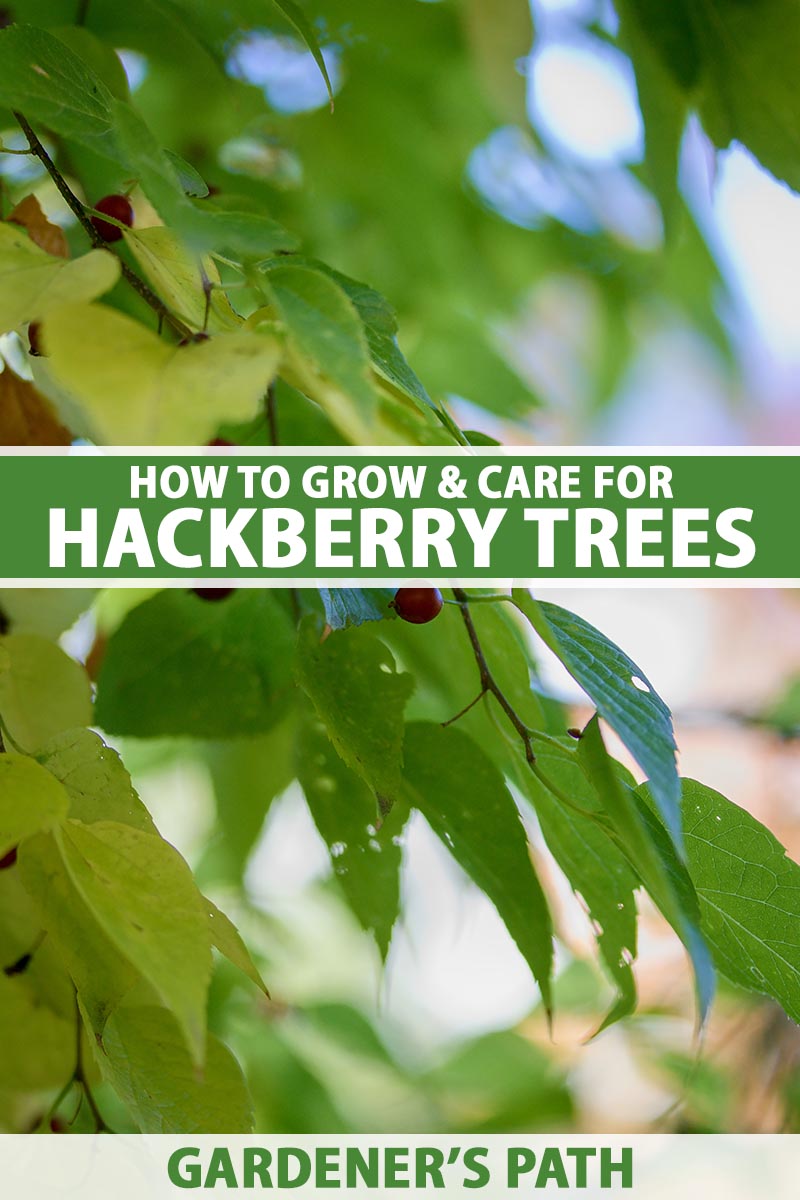
We link to vendors to help you find relevant products. If you buy from one of our links, we may earn a commission.
They’re ideal in landscapes because they grow fast and large, providing a bright green canopy. This is a desirable characteristic on its own, or it can act as a deciduous background for other plants in your yard.
Hackberries also have iconic bark, heavily ridged and resembling cracking mud, occasionally covered with wart-like bumps.
C. occidentalis produces pea-sized berries, which are initially a showy red-orange in the summer.
These turn a deep purple-black color to stand out against the pale yellow leaves in the fall. The berries also attract birds, which adds yet another layer of interest to the backyard view.
Hackberry trees can easily adapt to a range of pH levels, as well as moisture levels and soil types. They’re drought-tolerant, wind-resistant, and able to thrive where other species may struggle in your location.
They do drop those berries, however, so that’s something to keep in mind when considering your planting spot.
The antioxidant-rich berries are safe and edible for both humans and animals, but if you plant a hackberry near your front porch, driveway, or walkway, you might find it a chore to keep the mess of fallen fruit at bay.
Read on to discover all you need to know about these adaptable giants.
What You’ll Learn
Cultivation and History
Historically, hackberry trees have done exceptionally well on the plains and in the midwestern United States, though they grow all over from Canada down through most of the States.

As rapid growers, they can attain more than a foot of height each year in their first several years of life.
This species also goes by the names sugarberry and false elm. It has been used for medicinal purposes, to treat ailments including jaundice, menstrual cycle issues, and sore throats.
Hackberry wood is also used in making furniture or for smoking meat.
Propagation
While the hackberry can be grafted or grown from cuttings, your best chance at success is to grow it from seed, or transplant a small sapling.
From Seed
When propagating C. occidentalis indoors, gather fallen berries in the autumn and either allow them to air dry, or soak them and scrape the pulp off the seeds.
In the winter, place the seeds in a clear plastic bag containing soil that is moist, but not wet. Label the bag with the date.

Keep the bag in the refrigerator for 60 to 90 days. Once this period is complete and the seeds have started to split in the spring, plant the seeds in their permanent location about half an inch deep.
Cover them in a layer of mulch to prevent squirrels or other animals from digging them up.
If you live in a location that gets at least 60 to 90 days of cold weather with temperatures of 38°F or lower, you can direct sow hackberry seeds in their permanent location outdoors.
Keep the soil moist during germination and water the seedlings every week for the first year or two.
Transplanting
Hackberry saplings and seedlings respond well to transplanting. You can find healthy specimens both as bare root transplants, which are usually smaller saplings, or larger transplants with a root ball and the surrounding soil wrapped in burlap.
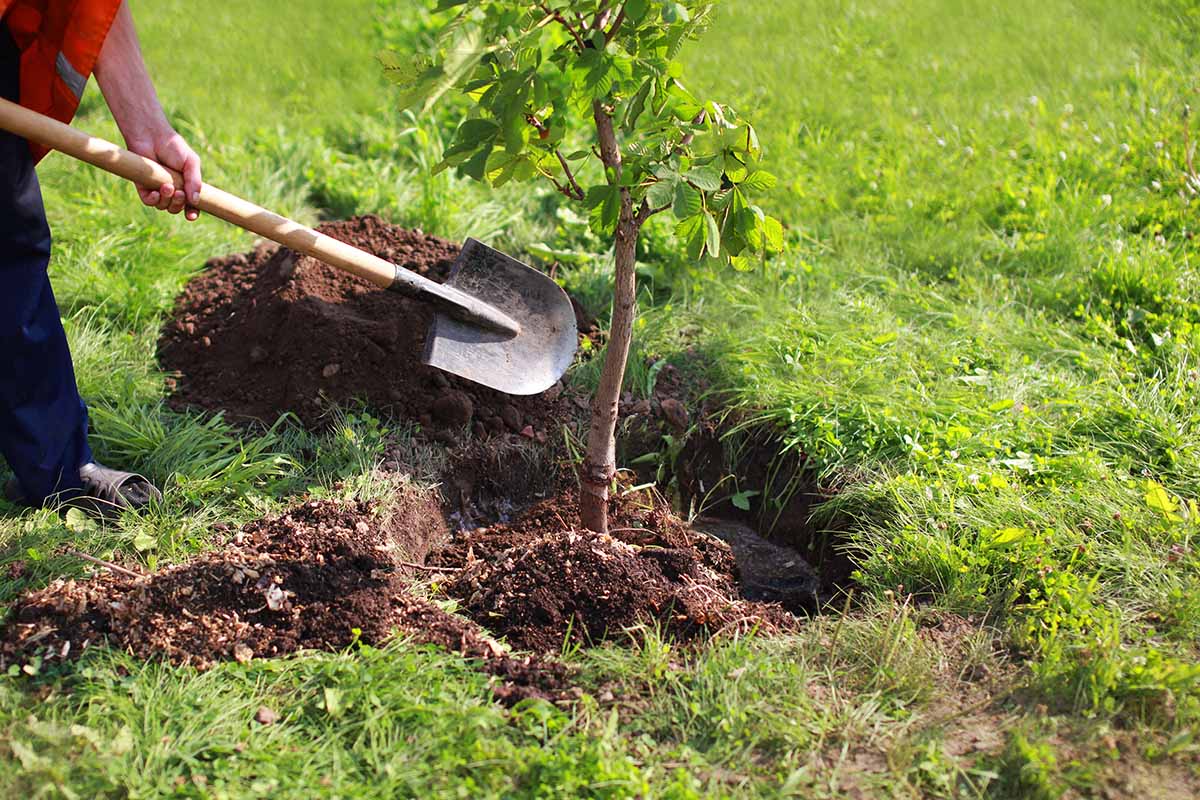
C. occidentalis can spread 25 to 45 feet at maturity, so be sure to keep appropriate spacing in mind when you plant. Consider the distance from other trees, fences, buildings, and power lines, as well as other plants and structures.
For saplings, dig a hole as deep as the root ball and twice as wide, stand the tree up straight in the hole, then fill the hole in with soil, tamping down with your feet every so often to make sure the soil settles in well to support it.
The more tender seedlings will need to be hardened off before planting. Bring them outside in mid- to late summer, then bring them back inside before winter.
Early the next spring, repot them in bigger containers, and repeat the process for one more year. The next spring, your hackberry seedlings can be planted outside in their permanent location.
Water your hackberry transplant every week to help it establish a healthy root system. Once your tree is strong and established, it will rarely need supplemental water.
How to Grow
Hackberry trees prefer rich, moist soil, but they can adapt to dry, heavy, sandy, or rocky soils, and can handle both acidic and alkaline soils. They also do fine in semi-wet soil or can adapt to very dry soils.
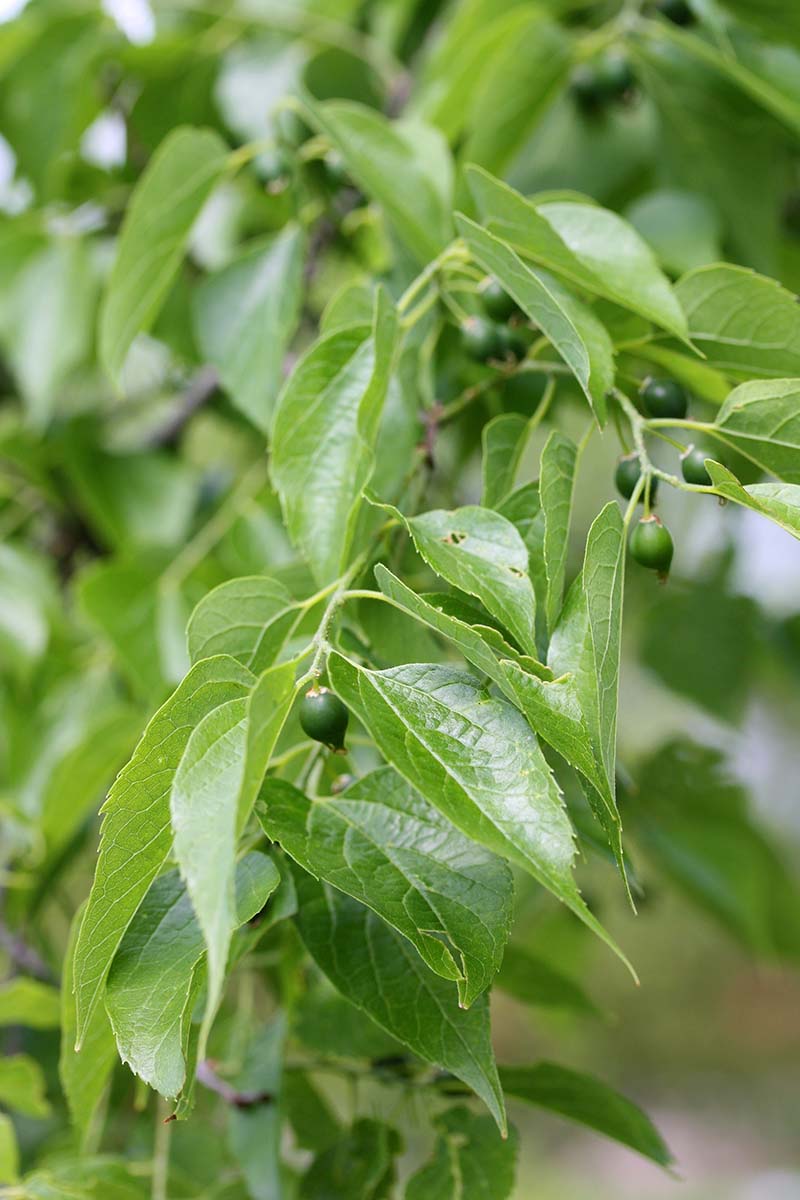
These versatile trees will grow in windy areas, can handle the heat and grime of urban environments, and enjoy full sun, though they will also tolerate partial shade.
During the first year after being transplanted, C. occidentalis will need to be watered every week or so to establish a strong root system. After that, this species won’t need much supplemental water – only the occasional watering in times of drought.
These trees don’t require much fertilizer to thrive, either. If you want to add fertilizer to your hackberry, it’s best to do so when it’s still a young sapling. You can use liquid, granular, or stake fertilizer. It will not need any fertilizer once it’s mature.
Growing Tips
- Plant your hackberry in a sunny location that’s large enough for it to spread to its mature size.
- Water weekly for the first year or so, until established.
- Fertilize new hackberries sparingly.
Pruning and Maintenance
In addition to raking up leaves and cleaning up dropped berries as needed, pruning is really the only maintenance your hackberry will need.

You can cut out small branches year round, but you should hold off on pruning larger branches until the dormant period in the late fall or winter, after the leaves have fallen.
Remove low-hanging, weak, or broken branches, and branches that touch or intersect with others.

When pruning, make a clean cut outside the branch collar. For large branches, under-cut the branch several inches from the trunk. Then overcut, undercut, and overcut, until the stub is at the branch collar.
This method will prevent you from accidentally tearing the tree past the branch collar, exposing your hackberry to infection.
Cultivars to Select
Celtis occidentalis is the species plant and the one you’ll find most often in nurseries and garden centers. At maturity, it will reach 50 to 75 feet tall and 30 to 40 feet wide.
Nature Hills Nursery carries hackberry saplings that are five to six feet tall.
And Fast Growing Trees carries several size options, between one and seven feet tall.
‘Prairie Pride’ is only slightly shorter than the species plant, but this cultivar is resistant to witches’-broom and produces fewer berries than most others.
‘Prairie Sentinel’ reaches the same lofty heights as the standard variety, but it only spreads about 12 feet wide, making it a great option for tighter spaces.
‘Ultrazam’ resembles the species plant in size, but its blue-green foliage helps it to stand out, as well as its resistance to fungal disease and pests.
Managing Pests and Disease
Most of the pests and diseases that may plague the hackberry are usually pretty harmless, but keeping an eye out for them can prevent issues down the road.
Pests
While there are a few pests that may affect this species, infestations aren’t usually life-threatening and can often be remedied by spraying with neem oil or water from the hose.
Aphids
The Asian wooly hackberry aphid, also known as Shivaphis celti, is an insect that sucks sap. It produces large amounts of a sticky honeydew, which can lead to sooty mold growth on leaves as well as surfaces and other plants growing beneath affected trees.
This is an issue if the tree is growing over sidewalks or parking lots in particular, as it makes a mess and causes mold issues. For this reason, the hackberry has been placed on some cities’ “do not plant” lists.
In the event of an aphid infestation, spraying neem oil on the leaves can help remedy the situation.
Learn more in our guide to dealing with aphids.
Mites
Eriophyid mites can cause galls, blisters, and curled and warty leaves, and infestations can lead to the formation of witches’-broom.
Many of these problems will not harm your hackberry, but they do affect the tree’s appearance. Mite infestations can be helped by spraying the leaves with a hose nozzle set to high power.
Mourning Cloak Butterflies
The mourning cloak butterfly, Nymphalis antiopa, will lay eggs in the hackberry tree, and the caterpillars that hatch out eat the leaves.
If they are consuming enough leaves that it negatively affects the look of your tree, you might consider applying a pesticide to combat large numbers of caterpillars.
Scale
Scale insects also produce honeydew, which may result in messy mold growth. Scale infestations can significantly weaken trees, leaving them more susceptible to other diseases and stressors as well.
To combat scale, horticultural oil can be sprayed on the affected areas.
Read more about identifying and controlling scale in our guide.
Disease
Most diseases that affect hackberry trees do not cause harm, and are mainly just aesthetic concerns.
Galls
Hackberry nipple gall can be caused by a few different types of insects, including psyllids, midges, and other gallmakers. Galls are bumps found on the underside of leaves.
These are usually just an aesthetic issue, a physiological ailment as opposed to a sign of infectious disease, though they can cause leaves to drop and interfere with photosynthesis in severe cases.
Insecticides can help to prevent pests from forming galls, but once formed, the effect on the leaves cannot be reversed.
Leaf Spot
Leaf spot is a fungal disease that presents as discolored spots on leaves. This can be prevented with a fungicidal foliar spray.
If your hackberries are affected, make sure the leaves are raked away at the end of the season.
The following spring, fungicidal leaf spray should be applied as the buds are beginning to break, and then again two or three more times through the spring in seven- to 14-day intervals.
Powdery Mildew
Powdery mildew, a fungal disease caused by Sphaerotheca phytophylla, can lead to the formation of witches’-broom.
Though not normally incredibly harmful to your tree, the fungus can be prevented and/or cured by pruning the canopy a bit to allow for better air circulation.
If your hackberry is affected by powdery mildew, hold off on adding any fertilizer, thin out some branches and remove any affected by the fungus, and make sure the infected branches are burned or tossed in the trash – not put on your compost pile.
Rot
Ganoderma rot is caused by a fungus that enters through wounds on the tree. This can happen, for example, if it’s cut by a weed-whacker or nicked by a lawnmower.
Adding mulch around the base of your hackberry can help protect it from damage, as well as taking care not to damage the trunk when maintaining your lawn.
In the instance of rot, the tree will begin to decline rapidly. Mushrooms may start to grow near the base, and these fruiting bodies of Ganoderma fungi are a sure sign that your tree is rotting.
If the hackberry has rotted, there’s a significant risk that it will not be able to withstand a wind storm and will need to be removed in the name of safety.
Sooty Mold
Sooty mold is a fungal disease that commonly crops up when pests leave honeydew behind. It covers the leaves and stems and can be quite messy.
This fungus can be cleaned up by thoroughly spraying insecticidal soap on the affected leaves and branches. Repeat this process as often as needed, until the sooty mold has been washed away and your hackberry leaves look clean once more.
An occasional spray of soapy water can also prevent sooty mold from developing.
Learn more about sooty mold in our guide.
Witches’-Broom
Witches’-broom is a common cosmetic problem, another physiological ailment that is usually the result of a powdery mildew infection or mite infestations. It is a deformity where a dense cluster of branches grows from a single point.
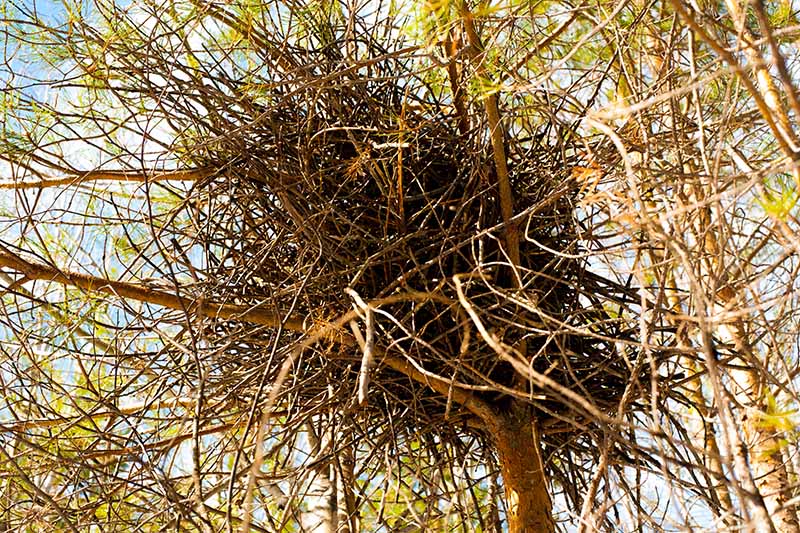
These do not harm the hackberry, but if you don’t like their appearance, pruning any affected branches will solve the problem. Be sure to address the root cause to prevent further spread and future issues.
Best Uses
C. occidentalis is perfect for those in cities who are looking for a tree that can stand up to heat and air pollution, provide shade, and beautify streets and sidewalks.

It’s also a great choice for homeowners looking for a large shade tree, especially in growing situations that are unsuitable for many other species.
The berries are edible and can be foraged in the late fall to winter when they are ripe, to be eaten raw as a snack, or ground into a paste for baking.
Quick Reference Growing Guide
| Plant Type: | Deciduous tree | Flower/Foliage Color: | Orange-red to purple fruits/light green foliage (yellow in fall) |
| Native to: | North America | Tolerance: | Drought, flooding, wind |
| Hardiness (USDA Zone): | 3-9 | Soil Type: | Various |
| Season: | April-May (insignificant flowers), summer-fall (berries) | Soil pH: | 6.0-8.0 |
| Exposure: | Full sun to partial shade | Soil Drainage: | Well-draining |
| Time to Maturity: | 15 years, lives for 150-200 years | Water Needs: | Low to moderate |
| Growth Rate: | Fast | Uses: | Edible berries, shade, woodworking, urban areas |
| Planting Depth: | 1/2 inch (seeds), depth of root ball (saplings) | Order: | Urticales |
| Height: | 40-60 feet | Family: | Ulmaceae |
| Spread: | 25-45 feet | Genus: | Celtis |
| Common Pests and Disease: | Asian wooly hackberry aphid, Eriophyid mite, mourning cloak butterfly, scale; Ganoderma rot, leaf spot, powdery mildew, sooty mold | Species: | Occidentalis |
Start Growing This Tough Tree
If you’re looking for a species that can withstand almost any environmental condition you can throw at it, the common hackberry is an ideal specimen.
It provides excellent shade, can thrive in most locations, and does well in the city and in spacious backyards.

The hackberry is an easygoing deciduous species that will provide you with shade and enjoyment soon after planting, without requiring a lot of care and upkeep.
Have you grown a hackberry tree of your own? Tell us about your experience in the comments below! And feel free to reach out with any questions.
And if you are looking for more landscape trees for your yard, have a read of these guides next:
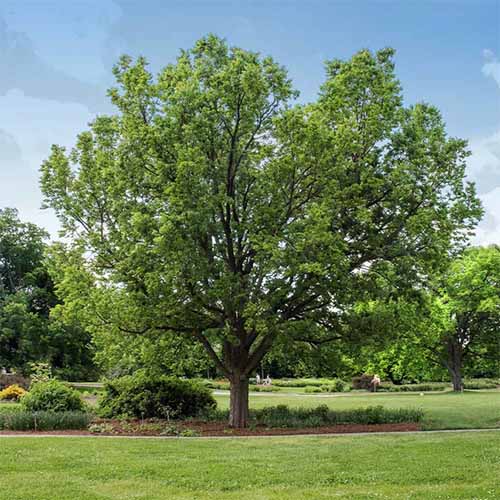
I think I have a hackberry growing in my yard. Can you confirm? Purple berries tast sweet and the nut tastes like amaretto.
Can you share photos, Timothy? Where are you located, and did you find the plant in a moist, well-irrigated area? Does the tree have thorns (not a hackberry- may be prickly ash), or raised spots that resemble warts on the bark? Do the leaves alternate along the stem, with branches that droop? I have to caution you against tasting foraged fruit until you’ve identified it with certainty, as many plants have lookalikes that may be toxic.
Hackberries are sweet, and some say they have a flavor similar to that of dates or figs.
I think this is the photo?
And the berries
Sorry I wasn’t able to access your photos yesterday! Yes, this does look like a hackberry to me.
We have a netleaf hackberry tree growing wild in our backyard but it looks like it has witches broom. I understand this disease doesn’t hurt the hackberry tree but is it contagious and harmful to other trees? We also have a number of mature citrus trees that we don’t want to put in danger.
Witches’ broom is a physiological condition rather than a disease caused by a contagious pathogen. What you’ll need to do is determine the cause of these growths for treatment – have you taken a look at the information about pests and disease above? Eriophyid mites may be the problem, but the damage they cause is usually more of an aesthetic nuisance than anything else. Witches’ broom in these plants can also be related to powdery mildew. If your citrus trees and other plants are otherwise healthy, you don’t need to worry.
Thank you! We are designing our back yard as an “edible garden” and, even though the hackberry tree sprouted up on its own and has been growing wild, I didn’t want to cut it down since the berries are edible.
You’re welcome! My best advice would be to keep an eye on the growing conditions- powdery mildew can be a sign of overly moist conditions and a lack of proper airflow, for example. Prune any damaged, diseased, or infested growth, and dispose of it in the trash (not on the compost pile).
Is this a young HACKBERRY TREE
Hello Tam, yes that is a young hackberry. It’s unusual to see those galls on the leaves, but that’s what they are–eggs laid by wasps that will eventually hatch into larvae.
When growing from seed can you direct plant outside if the winter temperatures fall below -20C or will that kill the germination? Trying them in a Canadian zone 2A area.
I honestly wouldn’t suggest doing that. It’s likely to be too cold and the seeds won’t germinate. These trees are typically hardy to Zone 3.